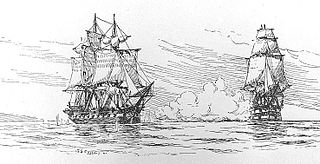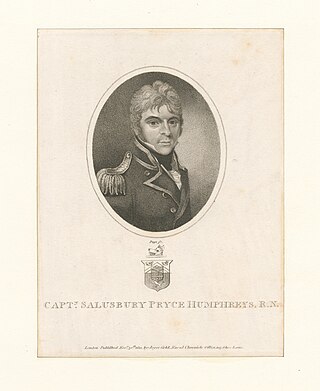
HMS Leopard was a 50-gun Portland class fourth rate of the Royal Navy. She served during the French Revolutionary and Napoleonic Wars, and was notable for the actions of her captain in 1807, which were emblematic of the tensions that later erupted in the War of 1812 between Britain and America. She was wrecked in 1814.

HMS Bermuda was an 18-gun sloop of the Royal Navy.
HMS Rover was a 16-gun sloop-of-war that the Royal Navy purchased in 1796, commissioned in 1798, and that was wrecked in early 1798. In her brief career she captured one French privateer.
HMS Olympia was an Adonis-class schooner of the Royal Navy during the Napoleonic War. She was built at Bermuda using Bermudan cedar and completed in 1806. In March 1811 the French captured her, but the British recaptured her in October. During her career, she served as far afield as Buenos Aires, Île Bourbon, and Cape of Good Hope. The Admiralty sold her in 1815.

HMS Halifax was a ship-rigged sloop of the Merlin class built in 1806 for the British Royal Navy at the Naval Yard in Halifax, Nova Scotia. Built to fill a pressing need for coastal patrol sloops on the North American Station, Halifax was one of the few warships built at Halifax Naval Yard in the Age of Sail as the yard's primary function was supply and refit.

HMS Ferret was a Royal Navy Cruizer-class brig-sloop built by Benjamin Tanner at Dartmouth and launched in 1806, 19 months late. She served on the Jamaica, Halifax, and Leith stations during which time she took three privateers as prizes before she was wrecked in 1813.
HMS Tang was a Royal Navy Ballahoo-class schooner of four 12-pounder carronades and a crew of 20. The prime contractor for the vessel was Goodrich & Co., in Bermuda, and she was launched in 1807. Like many of her class and the related Cuckoo-class schooners, she succumbed to the perils of the sea relatively early in her career.
HMS Woodcock was a Royal Navy Cuckoo-class schooner. Crane & Holmes built and launched her at Great Yarmouth in 1806. Like many of her class and the related Ballahoo-class schooners, she succumbed to the perils of the sea relatively early in her career.
HMS Crane was a Royal Navy Cuckoo-class schooner of four 12-pounder carronades and a crew of 20. She was built by Custance & Stone at Great Yarmouth and launched in 1806. Like many of her class and the related Ballahoo-class schooners, she succumbed to the perils of the sea relatively early in her career.
HMS Widgeon was a Royal Navy Cuckoo-class schooner built by William Wheaton at Brixham and launched in 1806. Like many of her class and the related Ballahoo-class schooners, she succumbed to the perils of the sea relatively early in her career.

Sir Salusbury Pryce Humphreys, later called Salusbury Pryce Davenport, was an officer of the Royal Navy who saw service during the French Revolutionary and Napoleonic Wars and the War of 1812, rising to the rank of rear admiral.
HMS Jaseur was originally the French Navy brig Jaseur that the Royal Navy captured in 1807 and took into service under the same name. She participated in one campaign and was lost in August 1808.
HMS Orpheus was a 32–gun fifth rate frigate of the Royal Navy. She was launched in 1780, and served for more than a quarter of a century, before she was wrecked in 1807.
HMS Bacchus was a schooner of the Adonis class of the Royal Navy during the Napoleonic War. She was built at Bermuda using Bermudan cedar and completed in mid-1806.
HMS Cassandra was an Adonis-class schooner of the Royal Navy during the Napoleonic War. She was built at Bermuda using Bermudan cedar and completed in 1806.
HMS Claudia was an Adonis-class schooner of the Royal Navy during the Napoleonic War. She was built at Bermuda using Bermudan cedar and completed in 1806. She was commissioned under Lieutenant Anthony Bliss William Lord in March 1806.

The French schooner Impériale was a 3-gun mercantile schooner-aviso of the French Navy commissioned at Guadeloupe on 23 September 1805. The Royal Navy captured her on 24 May 1806 and named her HMS Vigilant. The Navy renamed her HMS Subtle on 20 November 1806. She wrecked at Bermuda on 20 October 1807.
HMS Shamrock was a schooner built at Bermuda in 1808 of Bermuda cedar. She was built for the Royal Navy and was the name-ship of her class of 10-gun schooners. She was wrecked in 1811.
HMS Ranger was a merchant ship that the Royal Navy purchased on the stocks in May 1806. It registered her on 17 May 1806 as HMS Ranger but renamed her HMS Pigmy on 29 May 1806. Pigmy underwent fitting-out at Portsmouth between 12 June and 26 September 1806, apparently including conversion of her to a brig-rig.
HMS Redbridge was the mercantile schooner Union that the Royal Navy purchased in 1804. She wrecked at Nassau, Bahamas in November 1806.





